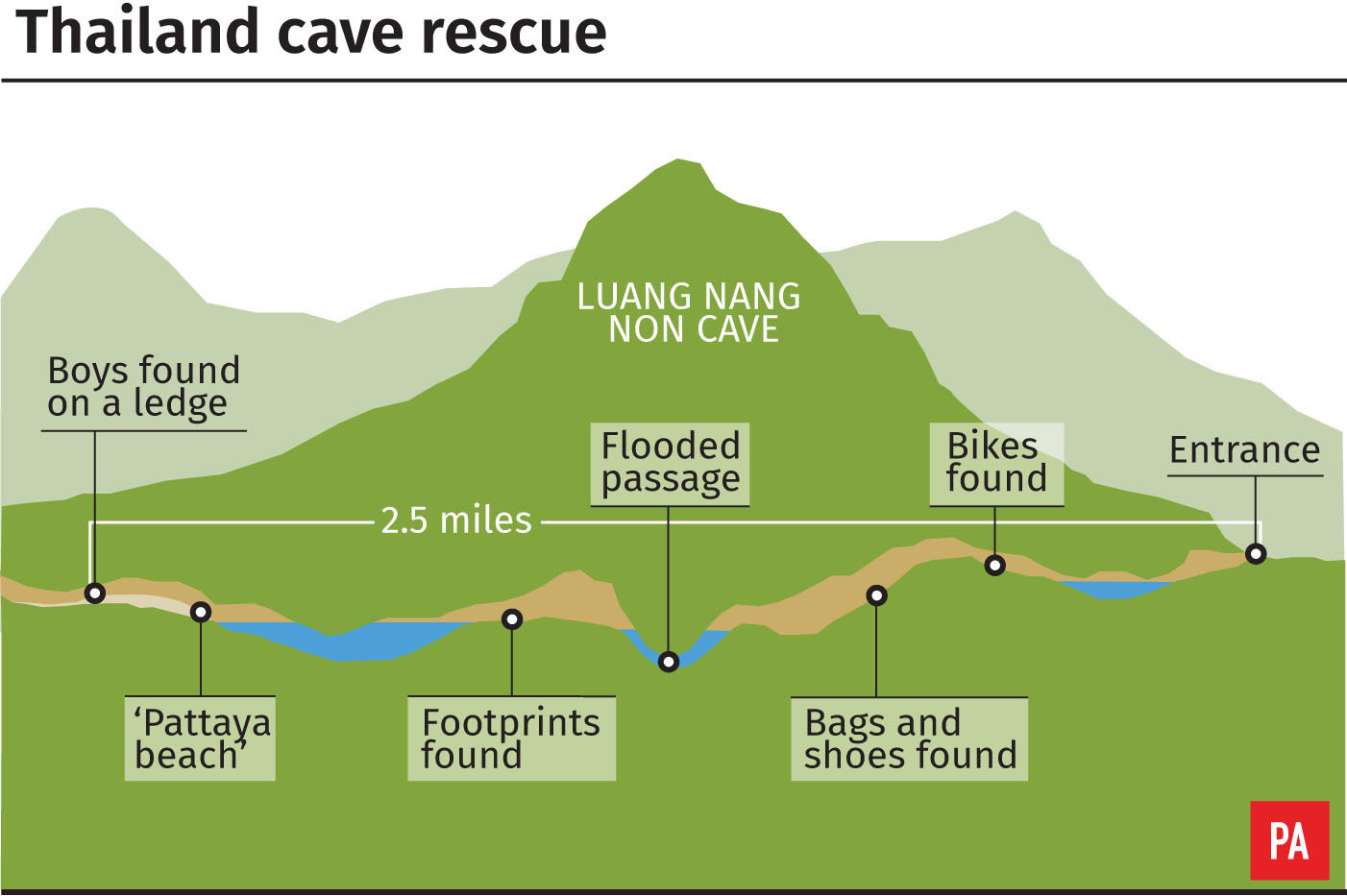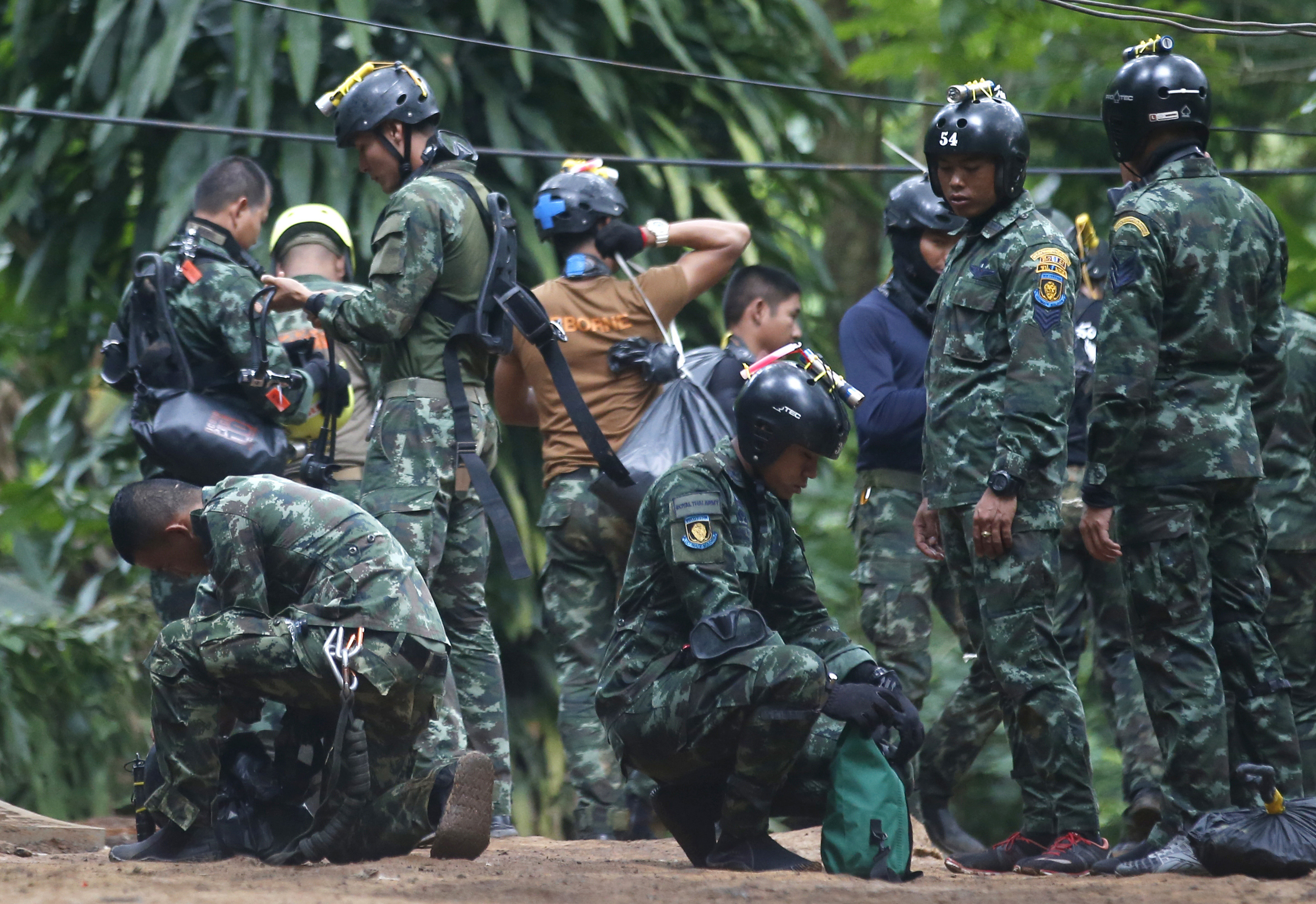
Thai authorities overseeing the rescue operation for 12 boys and their football coach trapped in a flooded cave said they have a “limited amount of time” to get them out after a diver died during the bid to free them.
Officials are racing against worsening weather and lowered oxygen levels in the underground complex in the country’s north.
The massive operation inside and around Tham Luang Nang Non cave in Chiang Rai province suffered its first fatality on Friday when a former Thai navy Seal passed out underwater on an overnight mission and was unable to be revived.
“We can no longer wait for all conditions (to be ready) because circumstances are pressuring us,” Thai Seal commander Arpakorn Yookongkaew told a news conference.
 (PA Graphics)
(PA Graphics)
“We originally thought the boys can stay safe inside the cave for quite some time but circumstances have changed. We have a limited amount of time,” he said.
The oxygen levels inside the cave were getting lower because of all the workers inside and authorities were working to run an oxygen line inside the complex that was in addition to the oxygen canisters used by divers, Chiang Rai governor Narongsak Osatanakorn said.
A senior army commander, Major General Chalongchai Chaiyakam, said that the most pressing mission now is to provide an oxygen line to reach the children, who are stuck deep in the complex but are being looked after by four Seals, including a medic.
He said the oxygen line is also tied to a telephone line that will provide a channel of communication for the children.
The boys, aged 11-16, and their 25-year-old coach went exploring in the cave after a football game on June 23.
Monsoon flooding cut off their escape and prevented rescuers from finding them for almost 10 days as the only way to reach them was by navigating a series of dark and tight passageways filled with muddy water and strong currents.
 Thai rescuers prepare to enter the cave (Sakchai Lalit/AP)
Thai rescuers prepare to enter the cave (Sakchai Lalit/AP)
Authorities have been racing to pump out water from the cave before more storms hit the region in the coming days and send water levels rising again.
At this time though, the only way for the boys to get out of the cave is by diving, something cave rescue experts warn is extremely dangerous even for those with experience.
Friday’s death of the former Seal underscores those risks.
The diver was working in a volunteer capacity and died during an overnight mission in which he was placing oxygen canisters along the route divers must take to get to the children, Mr Arpakorn said.
The strategically placed canisters allow divers to stay under water for longer during what is about a five-hour trip to reach the stranded team.
While underwater, the rescuer passed out and efforts to resuscitate him failed, Mr Arpakorn said.
Another navy official said he did not believe the man’s oxygen tank ran out.
“Despite this, we will continue until we accomplish our mission,” Mr Arpakorn said.
 Commander Arpakorn Yookongkaew (Sakchai Lalit/AP)
Commander Arpakorn Yookongkaew (Sakchai Lalit/AP)
The governor has said the 13 may not be extracted at the same time, depending on their condition.
The boys are weak but for the most part physically healthy.
They have practised wearing diving masks and breathing in preparation for the diving possibility.
Officials would prefer to get the boys out as soon as possible because heavy rain expected by Saturday will almost certainly raise water levels again in the cave, making passage in some areas even more difficult, if not impossible.
They are hoping that an upgraded draining effort can lower the water in an area where it is still at or near the ceiling.
The idea is to get some headroom so the boys would not be reliant on scuba apparatus for a long stretch and could keep their heads above water.
Cave rescue experts have said it could be safest to simply supply the boys where they are, and wait for the flooding to subside.
That could take months, however, given that Thailand’s rainy season typically lasts until October.
And without proper oxygen levels, staying put could also prove deadly.



Why are you making commenting on The Herald only available to subscribers?
It should have been a safe space for informed debate, somewhere for readers to discuss issues around the biggest stories of the day, but all too often the below the line comments on most websites have become bogged down by off-topic discussions and abuse.
heraldscotland.com is tackling this problem by allowing only subscribers to comment.
We are doing this to improve the experience for our loyal readers and we believe it will reduce the ability of trolls and troublemakers, who occasionally find their way onto our site, to abuse our journalists and readers. We also hope it will help the comments section fulfil its promise as a part of Scotland's conversation with itself.
We are lucky at The Herald. We are read by an informed, educated readership who can add their knowledge and insights to our stories.
That is invaluable.
We are making the subscriber-only change to support our valued readers, who tell us they don't want the site cluttered up with irrelevant comments, untruths and abuse.
In the past, the journalist’s job was to collect and distribute information to the audience. Technology means that readers can shape a discussion. We look forward to hearing from you on heraldscotland.com
Comments & Moderation
Readers’ comments: You are personally liable for the content of any comments you upload to this website, so please act responsibly. We do not pre-moderate or monitor readers’ comments appearing on our websites, but we do post-moderate in response to complaints we receive or otherwise when a potential problem comes to our attention. You can make a complaint by using the ‘report this post’ link . We may then apply our discretion under the user terms to amend or delete comments.
Post moderation is undertaken full-time 9am-6pm on weekdays, and on a part-time basis outwith those hours.
Read the rules here